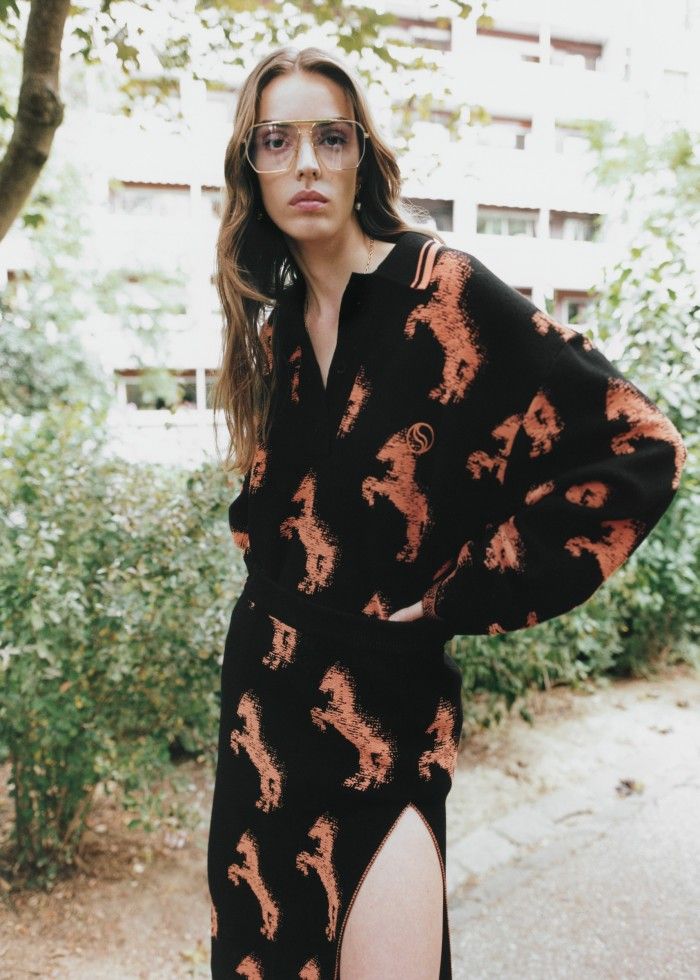Stay informed with free updates
Simply sign up to the Style myFT Digest — delivered directly to your inbox.
A pigsty is a curious place for inspiration, but that is where designers have been looking lately. First came the mud – great mounds of peat bog at Balenciaga’s SS23 show – then came the pig, duck and horse motifs for autumn. At Burberry, for his debut collection, Daniel Lee filled the runway with ducks, covering everything from jackets to dresses. Then there was Stella McCartney, whose latest collection features Appaloosa-themed jacquards in honour of her first horse, Harmony, while Christopher Kane’s autumn collection used AI to create slit dresses in piglet, chick and rat prints – although his inspiration was somewhat less rural. “We had a rodent issue in the ceiling of our studio,” the designer says. “We never saw them, but could hear them running around the pipes above our heads.”
The more illustrious the animal, the stronger its hold on the fashion industry: leopards and zebras, of course, have long been hot commodities. But quotidian creatures have appeal too. Daniel James Cole, adjunct assistant professor at New York’s Fashion Institute of Technology, explains that the surrealist movement made animals popular fodder for designers, resulting in a wave of garments that riffed on familiar shapes such as birds, bugs and dogs. Perhaps most famous are Elsa Schiaparelli’s horses, which adorned brooches and belts in her 1938 Circus collection. You can see the inspiration in Gilbert Adrian’s Roan Stallion dress from a few years later, where a galloping horse stretches from the neckline down to the knees. His other designs feature prancing lambs and pecking hens; Adrian took the farmyard and made it Golden Age-era Hollywood.

Designers have often flirted with simpler times. As Cole points out, a “country life theme ran through the 18th century”, most notably expressed by Marie Antoinette. The French queen popularised the chemise à la reine, a style of dress inspired by la vie paysanne (peasant life). These were frequently made of toile de Jouy, cloth printed with hunting scenes, farm animals and “people frolicking in the woods”. But this current trend could also just be a new iteration of cottagecore, the modern aesthetic based on a fanciful view of country living (posts with the tag #cottagecore have 14.3bn views on TikTok). It’s no secret that nostalgia triumphs during periods of unrest – and pigs and sheep offer an odd throwback to childhood. “It might be appealing to a sense of whimsy that we need,” affirms Cole, adding that the farmyard focus mixes this feeling with “a sense of familiarity that is comforting”.

For Rose Hudson, a print and graphics strategist at WGSN, the barnyard theme is indicative of a trend the agency calls “Park Life”. “It follows the resurgence of pastoral animal motifs, underpinned by a rustic and handcrafted feel,” she says. “Upcycling deadstock fabrics has also been on the rise, and is strengthening the use of these rural motifs.” This homespun comfort was particularly palpable at Bode – see the whimsically embroidered horse cardigan – and in the dangling orange legs of Burberry’s handknitted duck hat.

Yet farmyard symbolism can also offer an unflattering insight into fashion’s relationship with the animal kingdom. Recently there have been calls for a “species royalty” for the use of motifs such as leopard print; the idea being to give back to the animal and bridge the mental gap between a species and its image. For Joshua Katcher, a vegan menswear designer and author of Fashion Animals, this disconnect is particularly glaring when it comes to designers using leather, fur or wool. “When we use animals in fashion as symbols, we tend to strip them of their individuality, their inner life and their complexity,” he says. “Animals are reduced to two-dimensional symbols that represent things that flatter our egos.”

That’s not to say animal imagery is off-limits: it’s all about context. Stella McCartney’s horses are powerful because they represent a connection between animal and human. JW Anderson’s pigeon clutch makes an overlooked bird beautiful (in an enjoyably silly way). A pheasant outline on a Rydale shooting sock, however, is quite sinister: prey ideally shouldn’t be a fashion motif.
Italian label Collina Strada’s autumn/winter collection shone a light on animals “that are commonly consumed as food” for precisely this reason. “I sought to bridge the gap between our everyday lives and the natural world, prompting reflection on the interconnectedness of all living beings,” says founder Hillary Taymour of the pig ears and cattle-tag piercings that accompanied her chunky sweaters and loose tartan trousers.
As Katcher says, “We are fascinated by animals because we evolved alongside them. Most humans have an evolutionary and innate desire to commune with nature.” Fashion is just another way to show how we feel. And right now, it seems, the message is pig, cow and duck.
Model, Martina Bergamini at Oui management. Casting, Tiago Martins at Ben Grimes. Hair, Rimi Ura at Calliste Agency. Make-up, Mayumi Oda at Bryant Artists. Photographer’s assistant, Christian Varas. Stylist’s assistants, Amelie Richard and Rémy Yombo. Make-up assistant, Laurine Maciejewski

